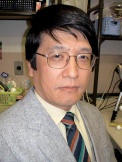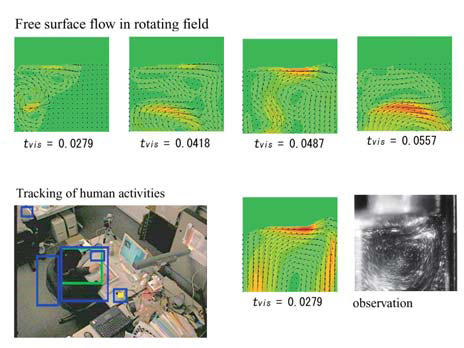Comprehensive List of Researchers "Information Knowledge"
Department of Complex Systems Science
- Name
- WATANABE, Takashi
- Group
- Complex Systems Computation Group
- Title
- Professor
- Degree
- Dr. of Engineering
- Research Field
- Fluid informatics / Computational fluid dynamics / Image processing

Current Research
Complex System of Material Flow and Information Flow
OUTLINEMovements of fluid and traffic flows are included in complex phenomena, and their investigation is important from physical point of views. We utilize discovery science and information science and construct fluid informatics to understand flows.
TOPICS
(1) Bifurcation Phenomena of Rotating Flows
While the flows around rotating cylinders and discs around a cylindrical enclosure have been investigated, their complex flow phenomena are not well understood. We introduced a new approach to examine these problems and clarified that the finite lengths of cylinders and the gap width between the disc and the enclosure cause drastic changes in the flow patterns. Our numerical results predicted non-unique flow modes at fixed values of extrinsic parameters and confirmed the mode by experiment. We are now studying the transient processes in which flows develop from rest to their final states. The results of this study will be useful to reduce the frictions of energy- conserving flying wheels and to optimally control flows in chemical reactors.
(2) Cooperative Control of Multiple Cameras
In the analysis of flow developments, it is necessary to obtain local images of flows, integrate those local images, and recognize the global flow field. For this purpose, we are constructing an image-sensing system that simultaneously observes moving objects and tracks specific objects. Observation by image sensors requires calibration of each camera, which is hard and tedious work. It is also difficult to identify a specific object in views obtained by local cameras. We developed a method that accepts the time-varying features of objects and specifies them. Then we presented a multiple-camera system where the cameras communicate with each other and dynamically determine their relative positions and orientations. Using these results, we have attained high performance of object tracking.
(3) Recognition of Human Behavior
We are considering a ubiquitous system that finds objects moved or left by human activities. We sometimes forget where we have left such belongings as keys and wallets, and we may also find any suspicious items in trains or in other public places. The system is intended to identify such objects. These objects are moved by human. Therefore, the system observes human activities and predicted actions which handle objects. A record of activities is used to determine when, where and by whom objects are moved. The current system is working in office environments and is presenting favorable results.
(4) Qualitative Physics in Fluid Dynamics
In communication between humans and computers, computers need basic knowledge about topics. Therefore, some kinds of ontology have been proposed in the areas of laws, biology, and others. We are constructing ontology in fluid mechanics area, especially on the topic of vortices. In this specific area, we can collect many examples of statements concerning the vortex. The semantic structures of these statements are summarized into a unique structure representing a vortex.
FUTURE WORK
For the computer-assisted analysis of flow phenomena, one key point is the human-machine interface which accepts the human recognition of fluid flows. We are developing two approaches to construct the mechanics. One is based on an ontology which understands expressions in fluid mechanics. The other uses discovery science and assists us to find what has been found in experimental results and numerical results. These approaches contribute to the development of information science as well as fluid engineering.

Figure : Free surface flows and tracking of actions
Career
- Takashi Watanabe graduated from Faculty of Engineering, Nagoya university in 1980.
- Takashi Watanabe graduated from Graduate School of Engineering, Nagoya university in 1985.
- He was a research associate of Nagoya university from 1985-1988.
- He was an associate professor in College of Liberal Arts from 1988-1993.
- He was an associate professor in School of Informatics ans Science from 1993-1998.
- He was a professor in Center of Information Media Studies,, Nagoya university in 1998.
- He joined the EcoTopia science institute, Nagoya university in 2005.
- Professor / Graduate School of Information Science, Nagoya university since 2009.
Academic Societies
- JSME
- IPSJ
- JSAI
- JSCES
- Association for the Advancement of Artificial Intelligence
Publications
- Mode formation of free surface rotating flow between concentric vertical cylinders, , J. Phys: Conf. Ser. 137 012007 (2008).
- Flows around rotating disks with and without rim-shroud gap, Experiments in Fluids, Vol. 48, No. 631-636 (2010).
- The effect of rim-shroud gap on the spiral rolls formed around a rotating disk, Physics of Fluids, Vol. 22, No. 11, 114107-1-7 (2010).
- Vertical Taylor-Couette Flow with Free Surface at Small Aspect Ratio, Acta Mechanics, Vol. 223, No. 2 (2012), pp. 347-353.
- Transition of the Flow around the Rotating Disk with a Radial Gap in a Cylindrical Casing with Increasing of the Reynolds Number, Trans. JSME, Ser. B, Vol. 78, No. 786 (2012-2), pp. 244-252.
- Cumulation of Walking Paths and Detection of Anomalies, Trans. JSME, Ser. C, Vol. 78, No. 788 (2012-4), pp. 1221-1225.








